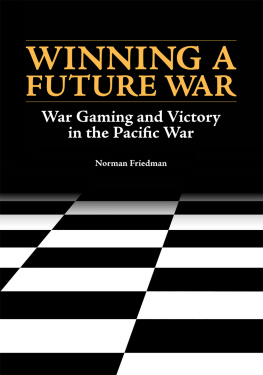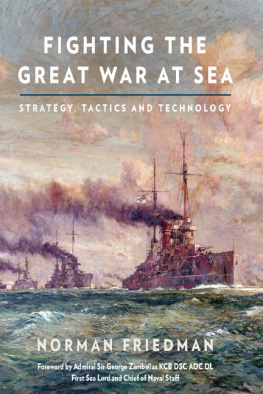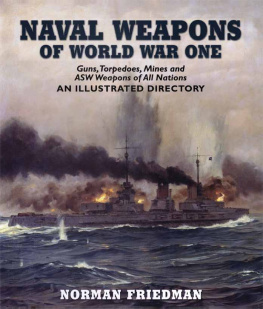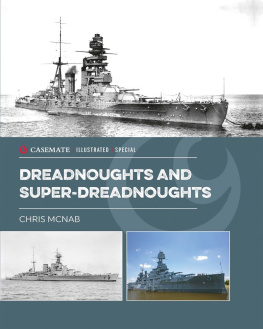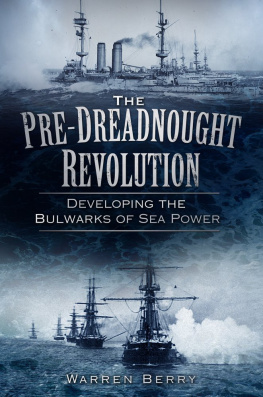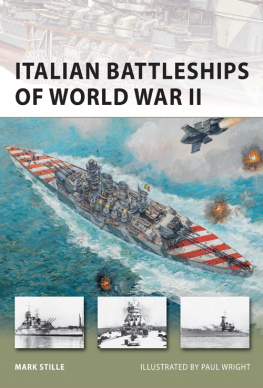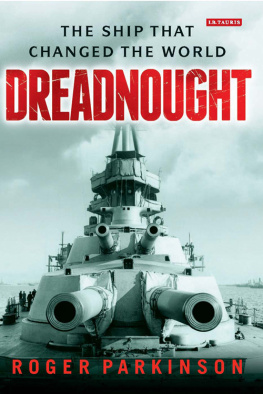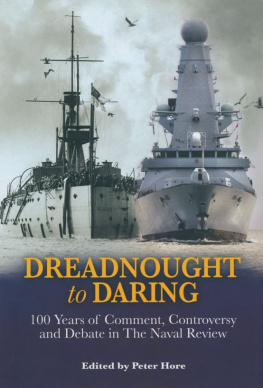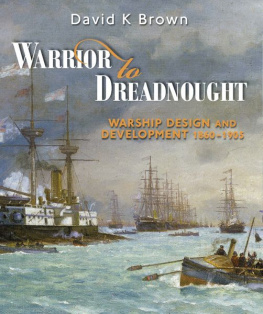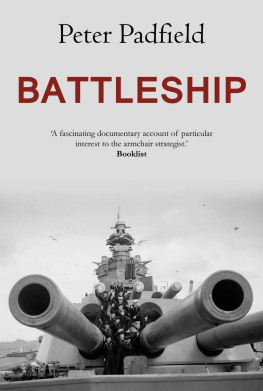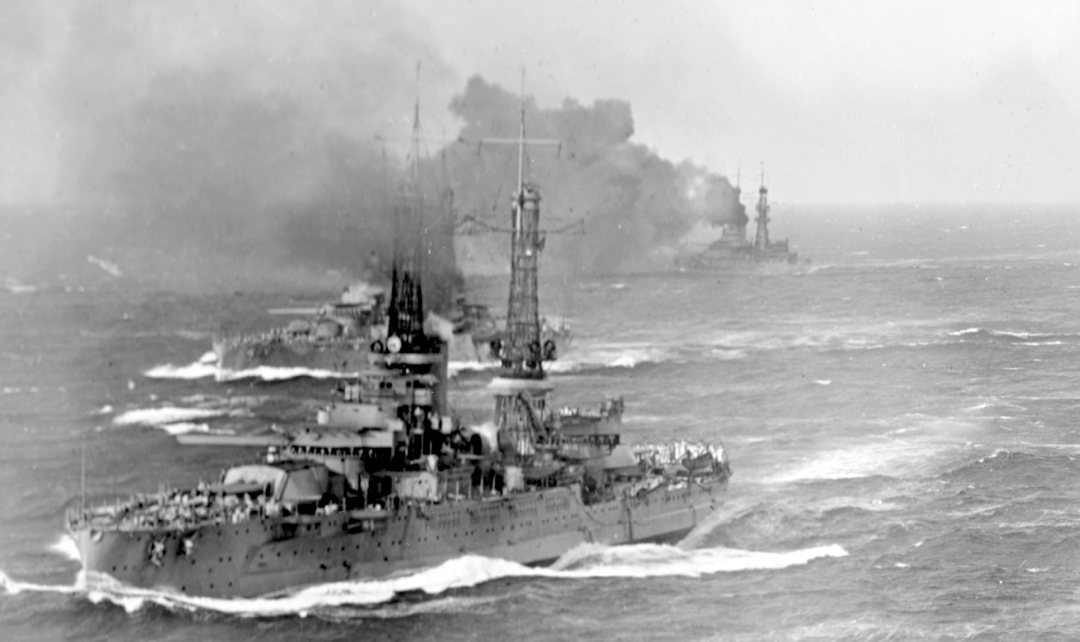
A US Battle Squadron is shown during gunnery practice in 1921. The leading ship is Nevada or Oklahoma, distinguishable by her pattern of secondary gun mounts. Note the characteristic US cage masts, intended to insure that ships could keep firing at long range despite mast hits, and the bearing markings on No 2 turret.
Copyright Norman Friedman 2008
First published in Great Britain in 2008 by
Seaforth Publishing
An imprint of Pen & Sword Books Ltd
47 Church Street, Barnsley
S Yorkshire S70 2AS
Website: www.seaforthpublishing.com
Email:
British Library Cataloguing in Publication Data
Friedman, Norman, 1946
Naval Firepower : battleship guns and gunnery in the dreadnought era
1. Fire control (Naval gunnery) - History 2. Battleships
History 3. Naval art and science - History - 19th century
4. Naval art and science - History - 20th century 5. Naval
history,Modern - 19th century 6. Naval history,Modern - 20th century
I. Title
623.55309
ISBN 978-1-84415-701-3
PAPERBACK ISBN: 978-1-84832-185-4
PDF ISBN: 9781473828216
EPUB ISBN: 9781844681761
PRC ISBN: 9781844681778
All rights reserved. No part of this publication may be reproduced or
transmitted in any form or by any means, electronic or mechanical, including
photocopying, recording, or any information storage and retrieval system,
without prior permission in writing of both the copyright owner and the
above publisher.
The right of Norman Friedman to be identified as the author of this work has
been asserted by him in accordance with the Copyright, Designs and Patents
Act 1988.
Designed and typeset by Roger Daniels
Printed and bound in Singapore
Contents
Note on units of measurement
I have used predominantly Imperial units of measurement (mainly yards and inches) rather than metric, because they were standard in the two most powerful battleship-era navies, the US Navy and the Royal Navy. Gun calibres in inches will be familiar to most readers. However, in those chapters about navies that used metric measurements, I have given the metric measurement first, with the Imperial conversion in brackets. Before the adoption of metric units, the typical unit for range was the yard; in gunnery 2000 yards was used for the nautical mile (it is actually slightly longer). A metre is slightly longer than a yard (1 metre is about 1.09 yards). For weights, a pound is slightly less than half a kilogram (1 kilogram is 2.204 pounds).
Notes on abbreviations
A glossary of terms and abbreviations is provided on . In the main text, terms set in italics are defined in this glossary.
Because they recur frequently in the endnotes () I have used the following abbreviations to indicate some sources:
DNOQ: Principal Questions Dealt with by DNO (18891911 in PRO) and Important Questions Dealt with by DNO (191214 in NHB).
DGBJ: Brooks, John, Dreadnought Gunnery and the Battle of Jutland: The Question of Fire Control (Abingdon: Routledge, 2005).
EHL: Historical Library at HMS Excellent at Portsmouth.
IDNS: Sumida, Jon Tetsuro, In Defense of Naval Supremacy: Finance, Technology, and British Naval Policy 18891914 (Boston: Unwin Hyman, 1989).
NARA: US National Archives and Records Agency.
NARA II: US National Archives and Records Agency outpost at College Park, Maryland.
NHB: Naval Historical Branch at Portsmouth.
PRO: The National (British) Archives at Kew (formerly the Public Record Office).
SHM: The Service Historique de la Marine of the French defence archive at Vincennes.
Details of US systems were generally taken from the:
OPs: Ordnance Pamphlets, which are often actually thick bound books).
ODs: Ordnance Data, usually typescript equivalents of OPs produced by blueprint, at College Park, Maryland; the main exception is the Mk 31 director.
The Ordnance Specifications (OS) for specific classes in the pre-World War II Bureau of Construction and Repair (RG 19) files at the US National Archives in central Washington describe many ships systems (they are much more detailed and specific than their title suggests).
Authors acknowledgements
Professor Jon Tetsuro Sumida, who should be credited with reviving the understanding of the importance of fire-control technology in twentieth-century naval warfare, was particularly generous with documents and advice. Dr Nicholas Lambert provided much valuable British material, and Stephen McLaughlin helped with extensive Russian material. Christopher C Wright, editor of Warship International and author of a series of recent articles on US battleship fire-control systems, shared his research material and also provided advance copies of some of his articles. Alexandre Sheldon-Dupleix provided material from the French archives, including a copy of the 1933 Italian naval fire-control text, which the French had obtained and translated (Dr Paul Halpern told me about this document). He also provided photographs and material from the trials reports of the battleship Dunkerque. Andrew J Smith provided Italian material. Steve Roberts provided some essential French material as well as invaluable advice on scanning. Mark Wertheimer of the US Naval Historical Center provided some important US documents.
For assistance with the US National Archives I am particularly grateful to Barry Zerby and Ken Johnson at College Park, Maryland and to Charles Johnson at the downtown archives. Captain Christopher Page RN (Retd) and his team at the Royal Naval Historical Branch (particularly Admiralty Librarian Jenny Wraight and Admiralty Archivist Kate Tildsley) in Portsmouth were extremely helpful, as was Lieutenant Commander Brian Witts RN (Retd), the curator (and creator) of the HMS Excellent historical collection. I am also very grateful to the staff of the Brass Foundry (an outpost of the National Maritime Museum) and to that of The (British) National Archive, which I continue to think of as the Public Record Office. John Spencer provided invaluable help navigating the French naval archives, as well as considerable other assistance. Randy Papadopulous of the US Navy Operational Archives helped with documents from the US Naval Technical Mission to Europe and with some US BuOrd material. The staff of the US Navy Department Library helped me find and copy some rare material including late interwar annual gunnery reports.
Most of the photographs were provided by Charles Haberlein (and his assistants Ed Finney and Robert Hanshew) of the photographic archives of the US Naval Historical Center and by A D Baker III, who also drew some of the illustrations. Dr Thomas C Hone provided some photographs, including the ones taken before the Bikini tests. John Asmussen of the Bismarck website (www.bismarck-class.dk) provided valuable photographs. I am grateful to William Jurens for many drawings, which are modified versions of ones he originally produced for Warship International. A D Baker III also created original drawings for this book. Except as noted at the end of individual captions, photographs are from the Naval Historical Center, the US National Archives and private collections.
The manuscript for this book was read in whole or in part (in various versions) by (in alphabetical order): A D Baker III, Christopher Carlson, Trent Hone, David C Isby, Dr Nicholas Lambert, Stephen McLaughlin, Andrew J Smith, John Spencer, Dr Jon Tetsuro Sumida, and Dr Alan Zimm. All provided helpful comments. The opinions expressed in this book are my own, however, and should not be attributed to any of my readers or helpers. Whatever errors have survived their perusal are entirely my own.
Next page

